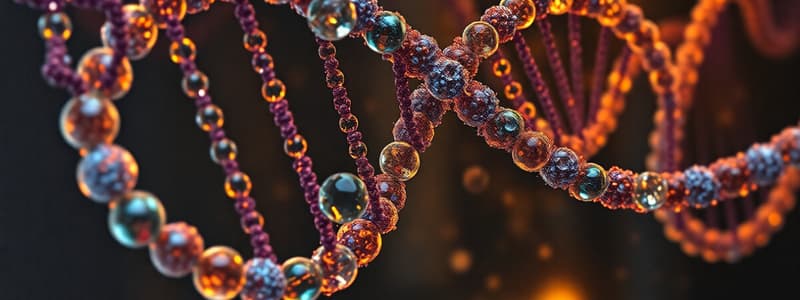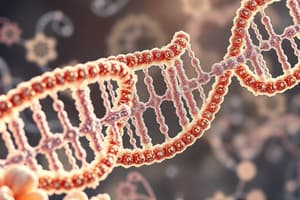Podcast
Questions and Answers
What initiates the separation of DNA strands during replication?
What initiates the separation of DNA strands during replication?
- Topoizomerase
- Single-Strand binding proteins
- Helicaze enzyme
- DNA-A protein (correct)
How does Topoizomerase resolve supercoiling in DNA?
How does Topoizomerase resolve supercoiling in DNA?
- By preventing the formation of replication bubbles
- By cutting one strand and then ligating it (correct)
- By cutting both strands and sealing them
- By unwinding the DNA through helicase action
Which enzyme is responsible for creating RNA primers during DNA replication?
Which enzyme is responsible for creating RNA primers during DNA replication?
- RNA polymerase
- DNA polymerase
- Primase (correct)
- DNA-dependent RNA polymerase
What is the consequence of Quinolones acting on bacterial Topoizomerase?
What is the consequence of Quinolones acting on bacterial Topoizomerase?
In which direction does DNA polymerase read the template DNA?
In which direction does DNA polymerase read the template DNA?
What structure forms once the DNA strands are separated at the point of origin?
What structure forms once the DNA strands are separated at the point of origin?
Which component binds to the strands of DNA to prevent them from reannealing?
Which component binds to the strands of DNA to prevent them from reannealing?
Which domain of Topoizomerase is responsible for cutting DNA strands?
Which domain of Topoizomerase is responsible for cutting DNA strands?
What role do supercoils play in DNA replication?
What role do supercoils play in DNA replication?
Which is a characteristic of bacterial DNA replication?
Which is a characteristic of bacterial DNA replication?
What is the primary function of the enzyme Primase in DNA replication?
What is the primary function of the enzyme Primase in DNA replication?
What distinguishes the leading strand from the lagging strand during DNA replication?
What distinguishes the leading strand from the lagging strand during DNA replication?
Which enzyme is responsible for removing RNA primers from the lagging strand?
Which enzyme is responsible for removing RNA primers from the lagging strand?
How does DNA Polymerase I deal with fragmented DNA on the lagging strand?
How does DNA Polymerase I deal with fragmented DNA on the lagging strand?
What triggers the synthesis of Okazaki fragments?
What triggers the synthesis of Okazaki fragments?
What happens when pseudonucleotides are incorporated into the DNA strand?
What happens when pseudonucleotides are incorporated into the DNA strand?
What role does DNA Ligase play in DNA replication?
What role does DNA Ligase play in DNA replication?
Which statement accurately describes the function of DNA Polymerase III?
Which statement accurately describes the function of DNA Polymerase III?
What is a characteristic feature of Okazaki fragments?
What is a characteristic feature of Okazaki fragments?
What occurs when DNA polymerase encounters a pseudonucleotide during synthesis?
What occurs when DNA polymerase encounters a pseudonucleotide during synthesis?
Flashcards
Origin of Replication
Origin of Replication
A location on DNA where replication begins, rich in adenine (A) and thymine (T) bases.
DNA-A Protein
DNA-A Protein
An enzyme that unwinds DNA at the origin of replication, separating the two strands.
Replication Bubble
Replication Bubble
The region of DNA where the two strands are separated, allowing replication to occur.
Single-Strand Binding Proteins (SSB Proteins)
Single-Strand Binding Proteins (SSB Proteins)
Signup and view all the flashcards
Helicaze
Helicaze
Signup and view all the flashcards
Supercoils
Supercoils
Signup and view all the flashcards
Topoizomerase
Topoizomerase
Signup and view all the flashcards
Nuclease Domain
Nuclease Domain
Signup and view all the flashcards
Ligase Domain
Ligase Domain
Signup and view all the flashcards
Quinolones
Quinolones
Signup and view all the flashcards
DNA Polymerase
DNA Polymerase
Signup and view all the flashcards
Proofreading
Proofreading
Signup and view all the flashcards
Exonuclease Domain
Exonuclease Domain
Signup and view all the flashcards
Leading Strand
Leading Strand
Signup and view all the flashcards
Lagging Strand
Lagging Strand
Signup and view all the flashcards
Primosome
Primosome
Signup and view all the flashcards
Okazaki Fragments
Okazaki Fragments
Signup and view all the flashcards
DNA Polymerase I
DNA Polymerase I
Signup and view all the flashcards
DNA Ligase
DNA Ligase
Signup and view all the flashcards
Pseudonucleotides
Pseudonucleotides
Signup and view all the flashcards
Study Notes
DNA Replication
- Replication begins by separating DNA strands at specific locations rich in adenine (A) and thymine (T) bases, called origins or consensus areas.
- Bacteria have a single origin, while others have multiple.
- DNA-A protein initially separates DNA strands.
- A replication bubble forms as the area opens.
- Single-strand binding proteins (SSBs) prevent the separated strands from reannealing.
- DNA is unwound further by helicase, requiring significant energy to break hydrogen bonds.
- Helicase works at replication forks, separating the strands.
- Supercoiling occurs downstream, which is relieved by topoisomerases.
- Topoisomerase has two domains: a nuclease domain that cuts DNA, and a ligase domain that rejoins the DNA.
Topoisomerase
- Topoisomerases, especially type II, help resolve DNA supercoiling during replication.
- Topoisomerases may have multiple types (e.g., Type I, Type II) performing different roles.
- Some antibiotics (e.g., quinolones) target topoisomerases, inhibiting bacterial DNA replication and causing cell death.
- Some cancer drugs (e.g., etoposide, teniposide) target human topoisomerases.
Initiation of Replication
- Primase (DNA-dependent RNA polymerase) creates RNA primers on the template strand.
- A primer provides a 3' end for DNA polymerase to attach nucleotides to.
DNA polymerase
- DNA polymerase is responsible for adding nucleotides to the newly synthesized strands.
- DNA polymerase performs multiple functions:
- It reads the DNA template in the 3' to 5' direction.
- It synthesizes new DNA strands in the 5' to 3' direction
- Prooves the new DNA strand
- If it finds errors it removes the nucleotide, and adds the correct one
- Different types of DNA polymerases exist.
Leading and Lagging Strands
- Leading strand synthesis occurs continuously in the 5' to 3' direction toward the replication fork.
- Lagging strand synthesis occurs in fragments (Okazaki fragments) away from the replication fork.
- Primase makes short RNA primers for each Okazaki fragment.
- DNA polymerase extends the fragments.
- DNA ligase connects the Okazaki fragments
Primosome
- Primase works with other proteins forming a complex called a primosome.
DNA Polymerase I
- DNA polymerase I removes the RNA primers and fills in the gaps with DNA nucleotides.
- This polymerase functions similarly to DNA polymerase III, but with a different role.
Altered Nucleotides
- Some drugs resemble nucleotides, interfering with DNA polymerase.
- The drugs are incorporated into the DNA, which prevents further DNA synthesis.
- These drugs are used in antiviral or anticancer medications.
Medications that affect Spindles
- Medications such as vincristine and vinblastine affect the mitotic spindle process.
Alternative Spindle Medications
- Medications that hyperstabilize mitotic spindles include paclitaxel and docetaxel.
Studying That Suits You
Use AI to generate personalized quizzes and flashcards to suit your learning preferences.
Related Documents
Description
This quiz covers the essential processes of DNA replication, including the formation of replication bubbles, the role of helicase, and the function of topoisomerases in managing DNA supercoiling. Understand the mechanisms that ensure accurate DNA replication and the significance of protein interactions during the process.



